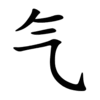气
Jump to navigation
Jump to search
| ||||||||
| ||||||||
Translingual
[edit]| Traditional | 氣 |
|---|---|
| Shinjitai | 気 |
| Simplified | 气 |
| Stroke order | |||
|---|---|---|---|
| Stroke order | |||
|---|---|---|---|

| |||
Han character
[edit]气 (Kangxi radical 84, 气+0, 4 strokes, cangjie input 人一弓 (OMN) or 難人一弓 (XOMN), four-corner 80017, composition ⿳𠂉一⺄)
- Kangxi radical #84, ⽓.
- Shuowen Jiezi radical №8
Derived characters
[edit]- Appendix:Chinese radical/气
- 㐹, 𠯏, 𡉛, 𪨦, 忾, 㧉, 汽, 𨸛, 𣅠, 䏗, 𣏙, 𪸕, 𤽍, 𥐬, 𥝬, 𥸽, 𥾨, 𫊨, 𧥷, 𧺞, 𨥊, 靔, 𩚤(饩), 𩡹, 𪌇, 㡮, 𪗟
- 刏, 㔕, 㪂, 㰟, 𩑡, 𩾻, 忥, 𧉁, 芞, 𥤶, 𤴸
Related characters
[edit]- 氣 (Orthodox traditional form)
References
[edit]- Kangxi Dictionary: page 599, character 3
- Dai Kanwa Jiten: character 17043
- Dae Jaweon: page 990, character 14
- Hanyu Da Zidian (first edition): volume 3, page 2010, character 1
- Unihan data for U+6C14
Chinese
[edit]Glyph origin
[edit]| Historical forms of the character 气 | ||||||
|---|---|---|---|---|---|---|
| Shang | Western Zhou | Spring and Autumn | Warring States | Shuowen Jiezi (compiled in Han) | Liushutong (compiled in Ming) | |
| Oracle bone script | Bronze inscriptions | Bronze inscriptions | Chu slip and silk script | Qin slip script | Small seal script | Transcribed ancient scripts |

|

|

|

|

|

|

|
Pictogram (象形) : clouds flowing through the sky – original form of both 氣 (OC *kʰɯds, *qʰɯds) and 乞 (OC *kʰɯds, *kʰɯd).
In the oracle bone script, it was represented by three horizontal strokes, expressing the "feeling" of the sky. However, in order to avoid confusion with the number 三 (OC *suːm, *suːms), 气 (OC *kʰɯds) was changed to draw a small stroke from top to bottom.
Etymology 1
[edit]| For pronunciation and definitions of 气 – see 氣 (“gas; air; etc.”). (This character is the simplified and variant form of 氣). |
Notes:
|
Etymology 2
[edit]| For pronunciation and definitions of 气 – see 乞 (“to beg; to request; etc.”). (This character is a variant form of 乞). |
Etymology 3
[edit]| For pronunciation and definitions of 气 – see 餼 (“foodgrain as a gift; foodgrain; etc.”). (This character is an ancient variant form of 餼). |
References
[edit]- Dictionary of Chinese Character Variants (教育部異體字字典), B01998
- Dictionary of Chinese Character Variants (教育部異體字字典), A02115-005#26
- Dictionary of Chinese Character Variants (教育部異體字字典), A00041-002#26
Japanese
[edit]Kanji
[edit]气
- steam radical (きがまえ (kigamae))
Readings
[edit]Usage notes
[edit]- This character exists only as a radical in Japanese. The corresponding character is 気 (“air; atmosphere; spirit”).
Vietnamese
[edit]Han character
[edit]气: Hán Việt readings: khí[1][2]
References
[edit]Categories:
- CJK Unified Ideographs block
- Han script characters
- Kangxi Radicals block
- CJKV characters simplified differently in Japan and China
- Han character radicals
- Translingual lemmas
- Translingual symbols
- Shuowen radicals
- Han pictograms
- Elementary Mandarin
- Intermediate Mandarin
- zh:Chemistry
- zh:Matter
- zh:Gases
- zh:Emotions
- zh:Atmosphere
- Chinese lemmas
- Mandarin lemmas
- Sichuanese lemmas
- Dungan lemmas
- Cantonese lemmas
- Taishanese lemmas
- Gan lemmas
- Hakka lemmas
- Jin lemmas
- Northern Min lemmas
- Eastern Min lemmas
- Hokkien lemmas
- Teochew lemmas
- Leizhou Min lemmas
- Southern Pinghua lemmas
- Wu lemmas
- Xiang lemmas
- Middle Chinese lemmas
- Old Chinese lemmas
- Chinese hanzi
- Mandarin hanzi
- Sichuanese hanzi
- Dungan hanzi
- Cantonese hanzi
- Taishanese hanzi
- Gan hanzi
- Hakka hanzi
- Jin hanzi
- Northern Min hanzi
- Eastern Min hanzi
- Hokkien hanzi
- Teochew hanzi
- Leizhou Min hanzi
- Southern Pinghua hanzi
- Wu hanzi
- Xiang hanzi
- Middle Chinese hanzi
- Old Chinese hanzi
- Chinese nouns
- Mandarin nouns
- Sichuanese nouns
- Dungan nouns
- Cantonese nouns
- Taishanese nouns
- Gan nouns
- Hakka nouns
- Jin nouns
- Northern Min nouns
- Eastern Min nouns
- Hokkien nouns
- Teochew nouns
- Leizhou Min nouns
- Southern Pinghua nouns
- Wu nouns
- Xiang nouns
- Middle Chinese nouns
- Old Chinese nouns
- Chinese verbs
- Mandarin verbs
- Sichuanese verbs
- Dungan verbs
- Cantonese verbs
- Taishanese verbs
- Gan verbs
- Hakka verbs
- Jin verbs
- Northern Min verbs
- Eastern Min verbs
- Hokkien verbs
- Teochew verbs
- Leizhou Min verbs
- Southern Pinghua verbs
- Wu verbs
- Xiang verbs
- Middle Chinese verbs
- Old Chinese verbs
- Chinese proper nouns
- Mandarin proper nouns
- Sichuanese proper nouns
- Dungan proper nouns
- Cantonese proper nouns
- Taishanese proper nouns
- Gan proper nouns
- Hakka proper nouns
- Jin proper nouns
- Northern Min proper nouns
- Eastern Min proper nouns
- Hokkien proper nouns
- Teochew proper nouns
- Leizhou Min proper nouns
- Southern Pinghua proper nouns
- Wu proper nouns
- Xiang proper nouns
- Middle Chinese proper nouns
- Old Chinese proper nouns
- Chinese terms spelled with 气
- Chinese simplified forms
- Chinese variant forms
- zh:Grains
- zh:Agriculture
- zh:Foods
- Japanese kanji
- Japanese hyōgai kanji
- Japanese kanji with goon reading け
- Japanese kanji with kan'on reading き
- Japanese kanji with kun reading いき
- Vietnamese Chữ Hán
- Vietnamese lemmas
- Vietnamese Han characters
